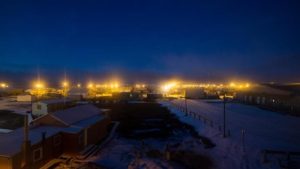
Residents Plunge Into Darkness Until January Next Year After Sun Sets For The Final Time In 2020 For Alaskan City
Residents have plunged into darkness until January of next year after the sun has set for the final time for this year for a city in Alaska.
Residents of Utqiaġvik, the Alaskan city formerly known as Barrow, saw the sunset on their house at 1:30 pm on Wednesday this week.
They will wait until January 2021 for the sun to rise again.
The annual happening is famously known as the polar night, where the sun is observed remaining below the horizon.
This happens because the earth tilts.
Utqiaġvik sits within the Arctic circle, which means that the residents of the city, around 4300 of them, will only get a small amount of sun.
The official term for this is called “civil twilight”.
The sun will remain below the horizon for the next 2 months, which means there will be no complete sunrise or sunset.
Talking about the phenomenon, Danielle Banks, a member of the Weather Channel, explained it by saying:
They are not going to see the sun in all its glory until late January, so that is more than two months. There’s not going to be complete darkness. There are a few hours each day with enough light to see, but the folks who live here have technically seen their last sunset until 2021.
The best thing about this is that you can watch the entire thing.
The University of Alaska Fairbanks has developed the very unique and popular Utqiaġvik Sea Ice Webcam.
The link that we placed above shows the rest of the world what the city looks like when the sun sets down for the final time.
On the official website, the university explains everything.
They say:
Apart from providing a visual impression of the sea-ice conditions off Barrow, these images establish a longer-term record of key dates in the seasonal evolution of the sea-ice cover, such as: onset of fall ice formation, formation of a stable ice cover, onset of spring melt, appearance of melt ponds, beginning of ice break-up in early summer, removal or advection of sea ice during the summer months.
There is also an opposite of this type of phenomenon.
In the Northern Hemisphere, during the warmer seasons from May and August, the polar day happens, where the sun does not set for over 2 months.
Man, imagine having bright days all the time and having darkness all the time.
What are your thoughts about this? Let us know what you think about it by leaving a comment in the comments section below!